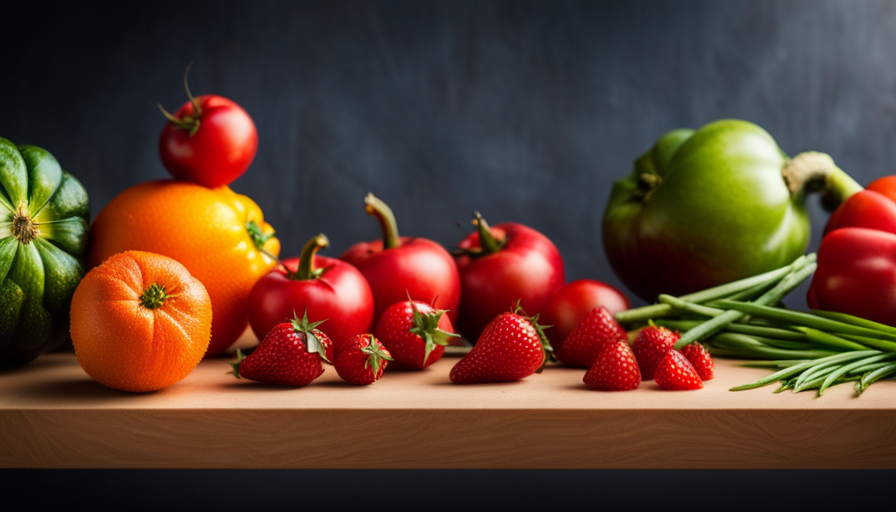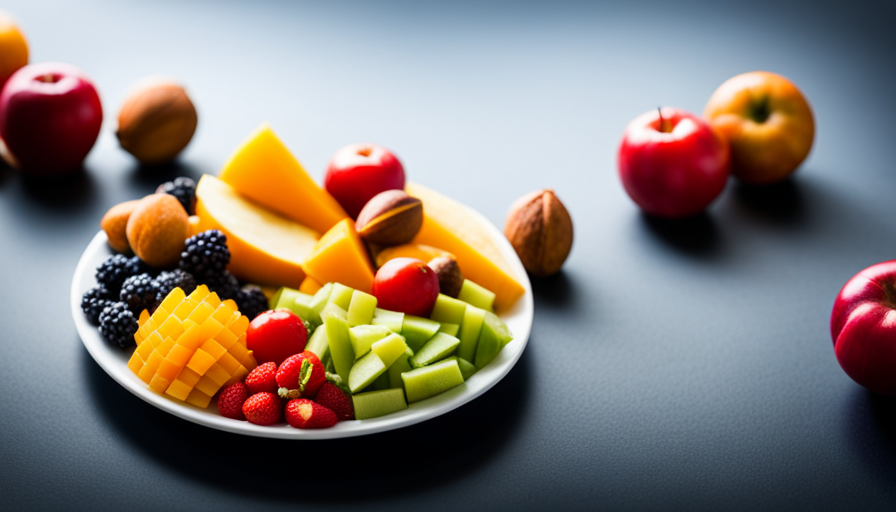I understand what you may be thinking: eating raw food? Isn’t that just for animals like rabbits? I used to have the same belief, but let me assure you, raw food is far more than just a simple salad.
It’s about embracing the power of nature’s bounty and nourishing your body in the most natural way possible.
In this article, we’ll explore the basics of raw food and why it’s gaining popularity among health enthusiasts. We’ll dive into the numerous benefits of a raw food diet, from increased energy levels to improved digestion.
You’ll also discover practical tips on how to incorporate more raw fruits and vegetables into your daily meals and explore different preparation techniques.
We’ll debunk common concerns and misconceptions surrounding raw food and provide solutions for transitioning to a raw food lifestyle.
So, get ready to transform your health and well-being by embracing the incredible potential of raw food.
Key Takeaways
- Raw food is rich in nutrients and enzymes that can be lost during cooking.
- Raw food is high in fiber, aiding in digestion and promoting bowel regularity.
- Raw food is generally lower in calories and fat, making it ideal for weight management.
- Raw food can increase energy levels, improve digestion, clear skin, and strengthen the immune system.
Understanding the Basics of Raw Food
When it comes to comprehending the fundamentals of raw food, it’s essential to grasp the basic principles of nutrition. Raw food refers to unprocessed, uncooked, and plant-based foods that are rich in vitamins, minerals, and enzymes.
Raw food recipes are centered around fruits, vegetables, nuts, seeds, and sprouted grains. These recipes emphasize the consumption of whole, unrefined foods in their natural state, without any cooking or heating techniques.
One of the benefits of raw food is that it retains all the nutrients and enzymes that can be lost during cooking. Enzymes play a vital role in digestion and metabolism, and they are preserved in raw food. Raw food is also high in fiber, which aids in digestion and promotes bowel regularity. Additionally, raw food is generally lower in calories and fat, making it an ideal choice for weight management.
Transitioning to a raw food diet can have numerous benefits for overall health and well-being. By consuming a variety of raw fruits, vegetables, and other plant-based foods, individuals can experience increased energy levels, improved digestion, clearer skin, and a strengthened immune system.
In the subsequent section, we will explore the specific benefits of a raw food diet without missing out on essential nutrients and maintaining a balanced lifestyle.
Benefits of a Raw Food Diet
With a raw food diet, your health and energy levels will skyrocket. Not only will you feel better physically, but you’ll also notice a significant improvement in your mental clarity and overall well-being. Here are some of the benefits you can expect from embracing a raw food lifestyle:
-
Increased vitality: Raw foods are rich in vitamins, minerals, and enzymes that are essential for optimal health. By incorporating more raw fruits and vegetables into your diet, you’ll provide your body with the nutrients it needs to thrive.
-
Improved digestion: Raw foods are easier for your body to digest, which can help alleviate digestive issues such as bloating and constipation. The high fiber content in raw fruits and vegetables also promotes a healthy digestive system.
-
Juicing benefits: Juicing is a popular way to consume raw fruits and vegetables. It allows you to extract the nutrients from a large quantity of produce in an easily digestible form. Juicing can provide a quick and convenient way to increase your intake of vitamins and minerals.
-
Raw food recipes: There are countless delicious and nutritious raw food recipes available. From refreshing smoothies and salads to hearty soups and desserts, you’ll never be short on options. Experimenting with raw food recipes can be fun and exciting, and it’ll help you discover new flavors and textures.
By incorporating raw fruits and vegetables into your diet, you’ll take a step towards a healthier and more vibrant life.
Incorporating Raw Fruits and Vegetables into Your Diet
When it comes to incorporating raw fruits and vegetables into my diet, I find that juicing and smoothies are a convenient and delicious way to get a boost of nutrients. I love experimenting with different combinations of fruits and veggies to create refreshing and nutritious drinks.
Additionally, salads and raw veggie dishes are a staple in my meal plan, as they provide a satisfying crunch and are packed with vitamins and minerals.
Lastly, raw fruit snacks and desserts are a guilt-free way for me to satisfy my sweet tooth while still nourishing my body with natural sugars and antioxidants.
Juicing and Smoothies
Smoothies are like a burst of sunshine for your taste buds, blending together vibrant fruits and vegetables to create a refreshing and nutritious treat.
Juicing and smoothies have gained popularity in recent years due to their numerous health benefits. Juicing allows you to extract the liquid from fruits and vegetables, providing a concentrated dose of vitamins, minerals, and antioxidants.
On the other hand, smoothies retain the fiber from the ingredients, keeping you fuller for longer and aiding in digestion. You can get creative with your smoothie recipes by combining different fruits, vegetables, and even adding some superfoods like chia seeds or spinach.
They are a quick and convenient way to incorporate raw fruits and vegetables into your diet.
Now, let’s transition into the next section about salads and raw veggie dishes, where we will explore more ways to enjoy the raw food goodness.
Salads and Raw Veggie Dishes
Get ready to tantalize your taste buds with the crisp and refreshing crunch of salads and raw veggie dishes. Raw food recipes are not only delicious but also packed with nutrients that are beneficial for our overall health. Eating raw vegetables and salads can provide a wide range of benefits, including improved digestion, increased energy levels, and enhanced weight management. The high fiber content in raw veggies promotes a healthy digestive system, while the vitamins and minerals help boost our immune system. Additionally, raw food recipes are often quick and easy to prepare, making them a practical choice for busy individuals. Incorporating a variety of raw vegetables into our diet can help us maintain a balanced and nutritious eating plan. So, let’s explore the world of raw fruit snacks and desserts to satisfy our sweet cravings.
Raw Fruit Snacks and Desserts
Indulge your sweet tooth with delectable raw fruit snacks and desserts that are bursting with flavor and nutrients. Raw fruit snacks and desserts aren’t just delicious but also packed with vitamins, minerals, and antioxidants that promote good health. Here are three mouthwatering options to try:
-
Raw fruit smoothies: Blend together a variety of fresh fruits like bananas, berries, and mangoes for a refreshing and nutritious drink. Add a splash of coconut water or almond milk for extra creaminess.
-
Raw fruit salads: Combine a medley of sliced fruits like watermelon, pineapple, and kiwi for a colorful and juicy treat. Drizzle with a squeeze of lime juice for a tangy twist.
-
Raw fruit parfaits: Layer chopped fruits with coconut yogurt and sprinkle with granola for a delightful and satisfying dessert.
Indulging in these raw fruit snacks and desserts is a guilt-free way to satisfy your cravings while nourishing your body. Now, let’s explore raw food preparation techniques.
Exploring Raw Food Preparation Techniques
Try experimenting with different raw food preparation techniques to unlock a world of flavors and textures that will leave you feeling as vibrant as a summer sunset. When it comes to exploring raw food recipes, there are numerous techniques that can enhance the taste and presentation of your dishes. From spiralizing vegetables to dehydrating fruits, these methods can add a new twist to your raw food journey.
One popular technique is marinating, which involves soaking fruits, vegetables, or even nuts in a flavorful liquid to infuse them with taste. This process not only adds depth to the ingredients but also softens them, making them easier to digest. Another technique is fermenting, where the natural bacteria present in food break down the sugars and create a tangy, probiotic-rich result. Fermented foods like sauerkraut and kimchi are not only delicious but also beneficial for gut health.
To make the writing more engaging, here is a table showcasing different raw food preparation techniques:
| Technique | Description |
|---|---|
| Spiralizing | Transforming vegetables into noodle-like shapes for salads or raw pasta dishes. |
| Dehydrating | Removing moisture from fruits, vegetables, or nuts to create crispy snacks or crackers. |
| Blending | Combining raw ingredients in a blender to create smoothies, soups, or sauces. |
| Sprouting | Germinating seeds or legumes to increase their nutrient content and enhance digestibility. |
| Juicing | Extracting the liquid from fruits and vegetables to make refreshing and nutrient-packed juices. |
By exploring these raw food preparation techniques, you can elevate your culinary experience and enjoy a variety of flavorful and nutritious dishes. Now let’s address common concerns and misconceptions about raw food.
Addressing Common Concerns and Misconceptions about Raw Food
When it comes to adopting a raw food diet, there are common concerns and misconceptions that need to be addressed.
One key point that often comes up is meeting nutritional needs. It’s important to understand that with proper planning and variety, a raw food diet can provide all the necessary nutrients our bodies need.
Additionally, ensuring food safety and hygiene is crucial when consuming raw foods, as there is a higher risk of foodborne illnesses. Proper handling, washing, and storage techniques can help minimize these risks.
Lastly, some individuals may experience digestive challenges when transitioning to a raw food diet. This can be due to the increased fiber intake or the body adjusting to a different way of processing food. It’s important to listen to our bodies and make any necessary adjustments to ensure optimal digestion.
Meeting Nutritional Needs
Satisfy your body’s nutritional needs by fueling it with wholesome raw foods. When it comes to meeting nutritional needs, understanding the basics of raw food is essential. Here are four key points to consider:
-
Nutrient Density: Raw foods tend to be rich in vitamins, minerals, enzymes, and antioxidants, which support overall health and well-being.
-
Digestive Enzymes: Raw foods contain natural enzymes that aid in digestion and improve nutrient absorption, leading to better overall digestion.
-
Fiber Content: Raw fruits, vegetables, and nuts are high in fiber, promoting a healthy digestive system and aiding in weight management.
-
Hydration: Raw foods are often high in water content, helping to keep the body hydrated and maintain optimal bodily functions.
By incorporating these key principles of raw food into your diet, you can ensure that your body receives the necessary nutrients for optimal health.
Moving on to the next section about food safety and hygiene, it’s crucial to maintain proper practices when handling raw foods to prevent any potential risks.
Food Safety and Hygiene
Ensuring proper food safety and hygiene is like conducting a symphony of cleanliness, orchestrating a harmonious balance to protect against potential risks. When it comes to raw food, these practices become even more crucial.
Raw food can harbor harmful bacteria such as salmonella and E. coli, which can cause foodborne illnesses. To minimize these risks, it’s essential to handle raw food with care. This includes washing hands thoroughly before and after handling raw food, using separate cutting boards for raw and cooked foods, and storing raw food at the proper temperature to prevent bacterial growth.
Additionally, maintaining a clean kitchen environment and regularly sanitizing utensils and surfaces is essential. By following these food safety and hygiene guidelines, we can reduce the chances of falling ill from consuming raw food.
Transitioning into the subsequent section about ‘digestive challenges’, it’s important to understand the impact of raw food on our digestive system.
Digestive Challenges
Navigating through digestive challenges can sometimes feel like a rollercoaster ride for your stomach. Digestive issues can range from occasional discomfort to chronic conditions that significantly impact your daily life.
Maintaining good gut health is essential for overall well-being, as our digestive system plays a crucial role in nutrient absorption and immune function. To support your digestive system, it’s important to eat a balanced diet, rich in fiber and probiotics. These can help regulate bowel movements and promote a healthy gut microbiome.
Additionally, staying hydrated and managing stress levels can also contribute to better digestive health. Taking small steps towards improving your digestion can lead to significant improvements in your overall health and well-being.
As we dive into the next section about raw food and sustainable living, it’s important to consider how our diet choices can impact both our digestive health and the environment.
Raw Food and Sustainable Living
Living a sustainable lifestyle goes hand in hand with incorporating raw food into your diet, as it not only nourishes your body but also has the power to save the planet. By choosing raw food, you’re supporting sustainable agriculture practices and reducing the environmental impact of your diet. Here are three reasons why raw food is a sustainable choice:
-
Reduced greenhouse gas emissions: Raw food diets often consist of fruits, vegetables, nuts, and seeds, which require fewer resources to grow compared to animal-based products. Livestock farming, on the other hand, contributes significantly to greenhouse gas emissions, deforestation, and water pollution. By choosing raw plant-based foods, you’re helping to reduce these harmful effects on the environment.
-
Conservation of water resources: Animal agriculture is a water-intensive industry, with large amounts of water required to raise livestock and grow animal feed. Raw food diets, especially those focused on locally sourced produce, generally require less water to produce. By opting for raw food, you’re conserving water resources and promoting sustainable water management.
-
Preservation of biodiversity: Sustainable agriculture practices, often associated with raw food diets, prioritize the preservation of biodiversity. By choosing organic, locally grown raw foods, you’re supporting farming methods that minimize the use of harmful pesticides and fertilizers, which can have detrimental effects on ecosystems and wildlife.
Transitioning to a raw food diet can be an exciting and rewarding journey. Let’s explore some practical tips to help you make the switch.
Tips for Transitioning to a Raw Food Diet
Start your journey towards a raw food diet by incorporating more vibrant and nutrient-rich fruits and vegetables into your daily meals. Transitioning to a raw food diet can be exciting and beneficial for your health. Here are some tips to help you make the switch successfully.
First, start by gradually increasing the amount of raw fruits and vegetables in your meals. This will allow your body to adjust and prevent any digestive discomfort. You can start with simple changes like adding a side salad or a piece of fruit to your meals. As you become more comfortable, you can experiment with raw food recipes and incorporate them into your daily routine.
It’s important to remember that a raw food diet isn’t about restriction, but rather about nourishing your body with wholesome, unprocessed foods. Focus on eating a variety of fruits, vegetables, nuts, and seeds to ensure you’re getting a wide range of nutrients. Get creative with your meals by trying new recipes and exploring different flavors and textures.
Transitioning to a raw food diet is a personal journey, and it’s essential to listen to your body and practice intuitive eating. Pay attention to how different foods make you feel and make adjustments accordingly. Trust your body’s signals and eat when you’re hungry, stopping when you’re satisfied. By listening to your body, you can create a sustainable and enjoyable raw food lifestyle.
Listening to Your Body and Practicing Intuitive Eating
Pay attention to the signals your body gives you and trust your instincts when it comes to nourishing yourself with wholesome, unprocessed choices. Listening to your body and practicing intuitive eating are essential skills for successfully transitioning to a raw food diet.
Here are three tips to help you develop these skills and enhance your mindful eating experience:
-
Mindful Awareness: Take the time to truly tune in to your body’s needs and pay attention to how different foods make you feel. Notice any changes in energy levels, digestion, or mood after eating certain raw foods. This awareness will help you make more informed choices and better understand what your body craves.
-
Slow Down and savor: Practice eating slowly and mindfully, savoring each bite. Engage all your senses and appreciate the texture, taste, and aroma of the raw foods you consume. This mindful approach not only enhances your enjoyment but also allows you to better recognize when you’re satisfied, preventing overeating.
-
Experiment and Adapt: Everyone’s nutritional needs and taste preferences are unique. Experiment with different raw food combinations, flavors, and textures to find what works best for you. Be open to adapting your diet as needed and listen to your body’s cues for variety, balance, and satisfaction.
By honing your listening skills and practicing mindful eating, you can fully embrace the benefits of a raw food lifestyle. However, there are potential challenges and solutions to consider when maintaining this way of eating.
[Transition to the next section]Potential Challenges and Solutions for Maintaining a Raw Food Lifestyle
Embracing a raw food lifestyle may present challenges, but fear not – there are solutions to help you maintain this nourishing way of eating. One of the main challenges of eating raw food is finding variety and convenience. It can be difficult to constantly come up with new and exciting raw food recipes, and it can also be time-consuming to prepare meals from scratch. However, there are solutions to these challenges. One solution is to plan your meals in advance and batch prepare certain ingredients to save time. Another solution is to explore different cuisines and flavors that naturally incorporate raw ingredients, such as Mediterranean or Asian cuisine. Additionally, there are many raw food recipe websites and cookbooks available that can provide inspiration and guidance.
Another challenge of a raw food lifestyle is the social aspect. It can be challenging to navigate social situations and dining out when your food choices are limited. However, there are solutions to this challenge as well. One solution is to communicate your dietary preferences to friends and family so they can accommodate your needs when planning meals or dining out together. Another solution is to research and find restaurants that offer raw food options or are willing to accommodate special requests. Additionally, joining raw food communities or support groups can provide a sense of connection and understanding.
While there may be challenges associated with maintaining a raw food lifestyle, there are always solutions available. By being prepared, exploring different cuisines, and finding support, it is possible to thrive on a raw food diet and enjoy the many health benefits it offers. So, let’s continue our journey towards optimal health and well-being with the power of raw food.
Conclusion: Embracing the Power of Raw Food for Optimal Health and Well-being
Explore the vibrant garden of health and vitality as you unlock the nourishing potential of a raw food lifestyle. Embracing raw food can have numerous health benefits that can positively impact your overall well-being. Here are four reasons why you should consider incorporating raw food into your diet:
-
Increased energy levels: Raw food is rich in essential nutrients and enzymes that are easily absorbed by the body, providing a natural energy boost. Say goodbye to afternoon slumps and hello to sustained vitality throughout the day.
-
Enhanced digestion: Raw food is packed with fiber, which aids in digestion and helps maintain a healthy gut. By embracing raw food, you can say goodbye to bloating and discomfort, and hello to a happy digestive system.
-
Improved skin health: Raw fruits and vegetables are high in antioxidants and vitamins that promote healthy skin. By nourishing your body with raw food, you can achieve a radiant complexion and a youthful glow.
-
Weight management: Raw food is naturally low in calories and high in nutrients, making it an excellent choice for weight management. Embracing raw food can help you maintain a healthy weight and support your overall fitness goals.
Embracing the power of raw food can bring about a multitude of health benefits. By incorporating raw food into your diet, you can experience increased energy, improved digestion, enhanced skin health, and effective weight management. So why wait? Start exploring the wonders of raw food and unlock a healthier, more vibrant you.
Frequently Asked Questions
Can I still get enough protein on a raw food diet?
Yes, it’s possible to get enough protein on a raw food diet. There are numerous protein sources that are suitable for a raw food diet, such as nuts, seeds, legumes, and sprouts. These foods provide essential amino acids, which are the building blocks of protein. Incorporating a variety of these protein sources can help ensure that you meet your daily protein requirements.
Additionally, a raw food diet has been associated with various health benefits, including improved digestion and increased energy levels.
Are there any specific safety concerns with consuming raw food?
When it comes to consuming raw food, there are indeed some safety concerns to keep in mind. One major concern is the risk of foodborne illnesses, such as Salmonella or E. coli, which can be present in raw foods.
Another concern is the potential for nutritional deficiencies, as certain nutrients may be compromised or less bioavailable in raw food.
It’s important to take proper precautions, such as washing produce thoroughly and ensuring proper food handling practices, to minimize these risks.
How can I incorporate more variety into my raw food diet?
To add more variety to my diet, I can incorporate flavors by trying different herbs and spices. Experimenting with different fruits and vegetables can also bring a new dimension to my meals. Adding nuts, seeds, and sprouts can provide different textures and flavors.
Additionally, exploring different raw food recipes and cuisines from around the world can introduce me to new flavors and combinations. Overall, these strategies can help me enjoy a diverse and satisfying raw food diet.
Is it possible to gain weight on a raw food diet?
Weight gain concerns on a raw food diet are valid, but it’s important to note that it’s not impossible to gain weight. One must pay attention to nutritional deficiencies that can occur due to limited food options. However, with careful planning and understanding of nutrient-rich raw foods, it is possible to maintain a healthy weight.
Including foods like nuts, avocados, and seeds can provide healthy fats and calories. Consulting with a nutritionist can help address specific concerns and ensure a balanced diet.
Can I still enjoy socializing and eating out while following a raw food diet?
Yes, it’s possible to enjoy socializing and eating out while following a raw food diet. Many restaurants now offer raw food options or are willing to accommodate special dietary needs. When dining out, you can choose fresh salads, vegetable sushi rolls, or even a fruit platter for dessert.
Additionally, you can still attend social events by bringing your own raw food dishes or snacks. It’s all about being prepared and making choices that align with your raw food lifestyle.
What Are the Benefits of a Raw Food Diet and How Does It Affect Your Health and Wellness?
Switching to a raw food daily diet can bring numerous health benefits. Raw foods are rich in nutrients and enzymes, which can improve digestion and boost energy levels. Additionally, a raw food diet can support weight loss, reduce the risk of chronic diseases, and enhance overall health and wellness.
Conclusion
After exploring the world of raw food and its numerous benefits, I’m convinced that embracing this lifestyle is the key to unlocking optimal health and well-being.
The power of raw food lies in its ability to nourish our bodies with pure, unadulterated nutrients. By incorporating raw fruits and vegetables into our diets and exploring various preparation techniques, we can experience a renewed sense of vitality.
Although there may be challenges along the way, the rewards far outweigh the difficulties. So go ahead, take that leap of faith and join me on this raw food journey. Your body will thank you.










